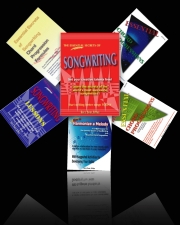Written by Gary Ewer, from “The Essential Secrets of Songwriting” website.
_______
 There’s a somewhat romantic notion out there that the best songwriters are the ones who just somehow create music without even knowing how they do it. It just flows. But that’s really not how it happens. True, there are songs that come together quickly, but even those ones require some measure of craft to make them work. If you’re stuck and can’t think of how to proceed, try thinking backwards.
There’s a somewhat romantic notion out there that the best songwriters are the ones who just somehow create music without even knowing how they do it. It just flows. But that’s really not how it happens. True, there are songs that come together quickly, but even those ones require some measure of craft to make them work. If you’re stuck and can’t think of how to proceed, try thinking backwards.
Songs are comprised of many different elements all working together. So if you’re stuck in the songwriting process, and can’t think of how to move forward, try identifying what the goal is – what you’re actually trying to do – and then move backward. Here’s how that might work:
MELODY:
Perhaps you’re in the opening few bars of working out your verse melody, but don’t know how to keep it going. If you’ve got at least the first few notes of your chorus working, you’ve actually achieved a goal for your verse. So to continue with your verse, think about the tessitura (the basic vocal range) of your chorus. If your song is in C major, and the chorus is up around the note G, go back to the verse and ensure that the opening of the verse is at least a 4th or 5th lower than your chorus. Then be sure that the bars leading up to the chorus feature some sort of ascending line that seamlessly attaches to your chorus.
HARMONY:
If you’ve got the first bar or two of a chord progression, but can’t think of what to do next, look ahead: what is the goal of that harmonic progression? It’s likely that your chords are going to come back to the chord you started with, and that’s usually the I-chord. So on your note pad, write a I-chord as a goal, and think, “How do I get to that chord.” Perhaps you reach one by playing the ii-chord just before it, so write that down. Then play those two chords over and over, and try to think of a chord that might easily move to the ii-chord: perhaps a IV or a vi. Then go back to the beginning, and try to move from the I-chord to something else, and continue to fill in the centre chords from both directions.
LYRIC:
Lyrics serve different purposes depending on where they are in your song. A verse lyric is a narrative-style recounting of a story; a chorus lyric tends to express more of the emotion of the situation: how the events of the verse make you feel. Bridge lyrics usually feature a quick back-and-forth between recounting and emotive response. If you’re stuck in any one stage, you may be able to get moving by setting a goal for a later section of your song. That sometimes opens the floodgates as it provides a goal for earlier sections. If your verse feels like an aimless wandering of events or moments in your life, set a goal for your chorus (“I can’t live, if living is without you..” for example), then the earlier verse will often come more clearly to your mind (“No, I can’t forget this evening,/Or your face as you were leaving.”)
We often describe a good song as a “journey” that we take the listener on. If we’re lost on a journey, it’s not likely we’d say that we don’t know where we want to be. On a journey, we usually know where we want to be; we just don’t know how to get there. Well, with songwriting, sometimes all it takes is reminding ourselves of where we want to be, and the path there will come more clearly into view.
___________________
 Download Gary Ewer’s “The Essential Secrets of Songwriting” suite of songwriting e-books, open your mind, and unleash the songwriting talent within you!
Download Gary Ewer’s “The Essential Secrets of Songwriting” suite of songwriting e-books, open your mind, and unleash the songwriting talent within you!









